
Japanese writer and publicist based in Eindhoven, The Netherlands
 Fokko Wieringa, the Principal Scientist at Imec at Holst Centre, is working on the development of an implantable artificial kidney.
Fokko Wieringa, the Principal Scientist at Imec at Holst Centre, is working on the development of an implantable artificial kidney.
Japan is known as "the country of health and longevity", but do you know that it is actually one of the world's leading "dialysis powerhouses"? Approximately 1 in 350 people are suffering from chronic renal failure and go to the hospital three times a week for hemodialysis. The number is increasing year by year.
The life of repeated hospital visits for dialysis makes it difficult to travel and work, and the quality of life (QOL) is damaged significantly. In addition, dialysis is a heavy burden on the body, and the expected average survival time for hemodialysis patients is about 10 years in Japan for 60-year-old and only 5 to 6 years in the U.S.
In the present time, when instant communication is wirelessly done and chips become smaller and smaller thanks to nanotechnology, does dialysis treatment really have to be done this way?
Dr. Fokko Wieringa, Principal Scientist at Imec, an international research institute, is working on a portable dialysis machine that can be carried around and even foresees an artificial kidney that can be implanted in the human body, calling on the stakeholders around the world to cooperate.
According to the Japanese Society for Dialysis Therapy (JSDT), the number of chronic dialysis patients is about 348,000 as of 2020. The prevalence of dialysis patients per million population in Japan is 2,750, which is the second highest in the world after Taiwan. Unfortunately, Japan is a “dialysis superhouse” in the world.
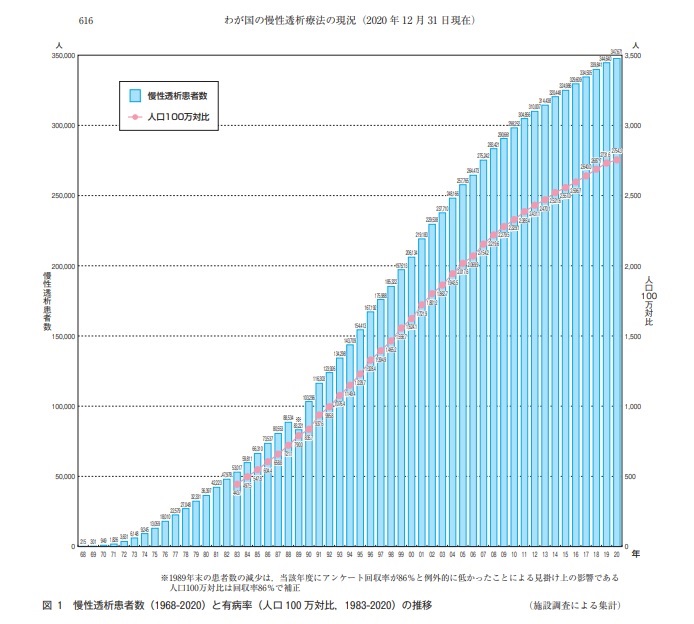
The number of chronic dialysis patients and prevalence (per million population) in Japan from 1968 to 2020 (Source: JSDT, 2020 Survey Report)
According to the Ministry of Health, Labour and Welfare in Japan, the monthly costs of dialysis per patient is about 400,000 yen and the annual medical costs of dialysis treatment in Japan is estimated about 1.6 trillion yen (about 4% of the total medical costs).
As the population ages, the number of lifestyle-related diseases is increasing. Diabetic nephropathy accounts for approximately 40% of the cases leading to dialysis, and nephrosclerosis has been on the rise for many years.
Treatment options for chronic renal failure include kidney transplantation and dialysis, but hemodialysis is currently the mainstream method due to the shortage of kidney donors for the transplantation. Hemodialysis takes 3 days a week, 4 hours per session, and puts a lot of strain on the body, leaving the patient exhausted after the treatment. It is extremely painful for both the patient and the family.
But according to Wieringa, it is quite possible to solve this problem with the current technology.
Wieringa and his consortium colleagues from NextKidney (Switzerland), Dialyss (Singapore) and the Dutch Kidney Foundation are currently developing a portable artificial kidney that fits in a carry-on sized suitcase for the aeroplane at the Dutch research institute "Holst Centre" in Eindhoven. The prospect of realization is 2024.
Traditionally, a hemodialysis machine is about the size of a refrigerator and requires 70 to 120 litters of water (dialysis solution) per treatment, but their portable dialysis machine needs only 6 liters. In addition, any ordinary household ungrounded electricity outlet (110/220V) can be used, and the power consumption is greatly reduced.
"Not only does it dramatically improve the QOL of dialysis patients, it is also very eco-friendly and cost effective." (Wieringa)
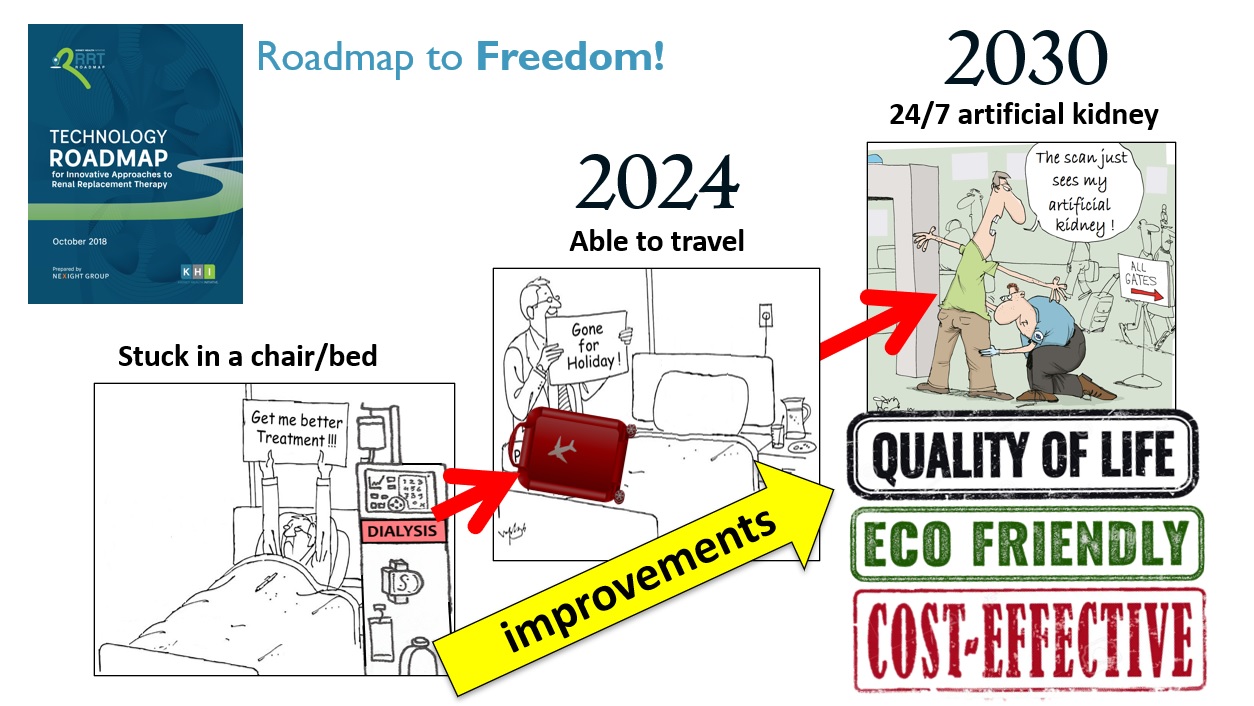 Roadmap for artificial kidney technology by Kidney Health Initiative (KHI), a consortium formed in the United States for the purpose of improving the safety of kidney disease patients and developing new treatment methods.
Roadmap for artificial kidney technology by Kidney Health Initiative (KHI), a consortium formed in the United States for the purpose of improving the safety of kidney disease patients and developing new treatment methods.
But their research plans even go beyond the portable artificial kidney. Holst Centre is aiming for the realization of the implantable artificial kidney in 2030, by bringing "Organ-on-Chip” on which highly biocompatible materials are used, and nanotechnology together from various research groups worldwide.
If it is achieved, the freedom of dialysis patients will be further increased. What's more, Wieringa said the cost of dialysis could be cut by 60 to 80 percent. It would contribute greatly to the reduction of medical expenses in Japan (and across the world).
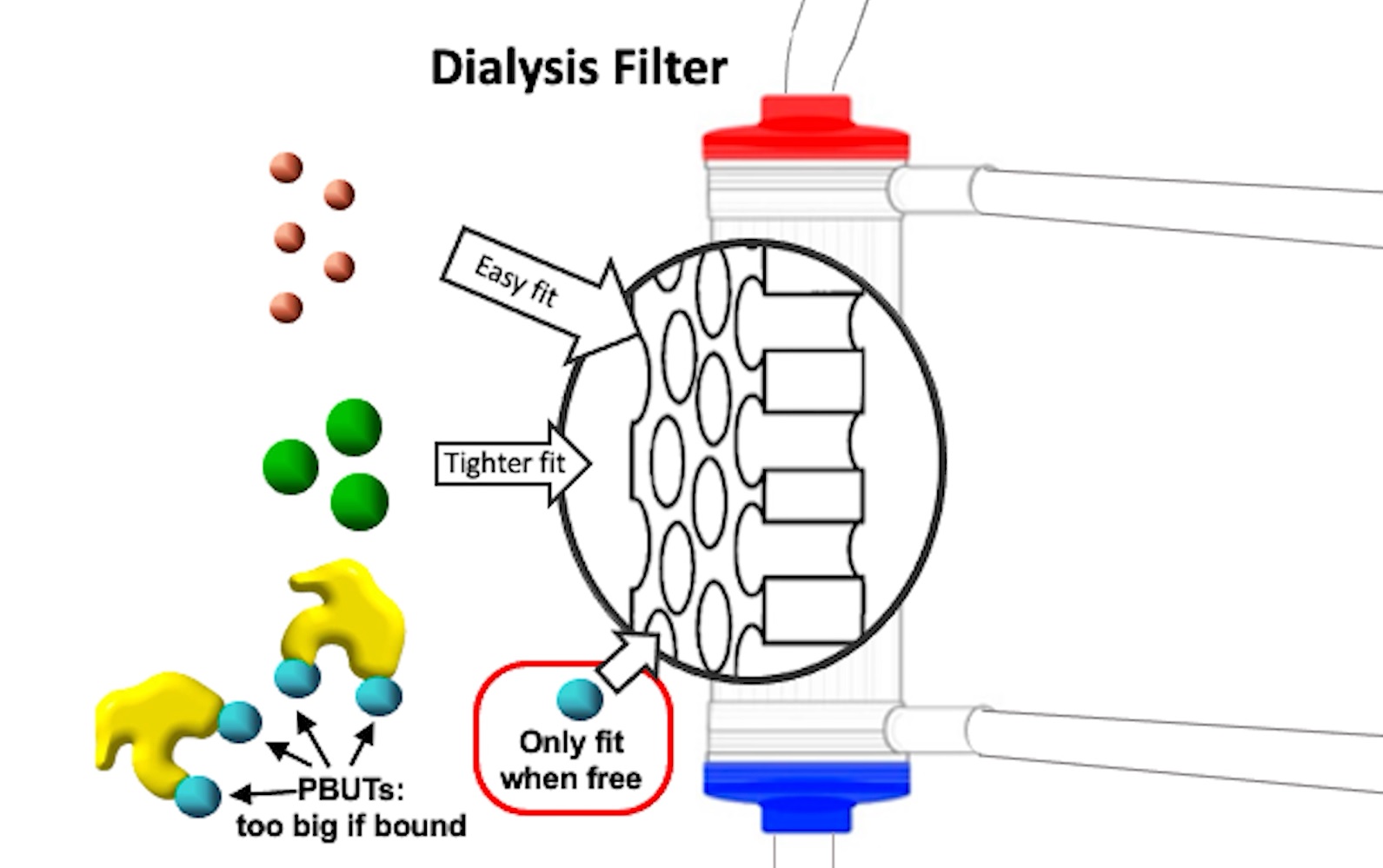 Protein-bound uremic toxins (PBUTs) cannot pass through the holes in the dialyzer's filter and are left in the blood.
Protein-bound uremic toxins (PBUTs) cannot pass through the holes in the dialyzer's filter and are left in the blood.
In an attempt to reproduce kidney function using state-of-the-art technology, Wieringa and colleagues first pursued research to improve the efficacy of existing hemodialysis.
In hemodialysis, blood is passed through a tubular filter device called, "dialyzer" that partly mimics filtration of the kidney. Toxic waste molecules and electrolytes in the blood are transferred to the dialysate on another side of the filter membrane. Only molecules that are small enough to pass through the holes in the filter are removed. Toxins that are attached to large plasma proteins (protein-bound uremic toxins = PBUTs) remain in the blood.
Professor Joachim Jankowski (Aachen, Germany) discovered that when the plasma protein was exposed to radio waves and resonated, more PBUTs were cut off from the proteins and could be better drained through the holes in the filter. But this required a desktop full of big and expensive equipment and caused radio disturbance around it.
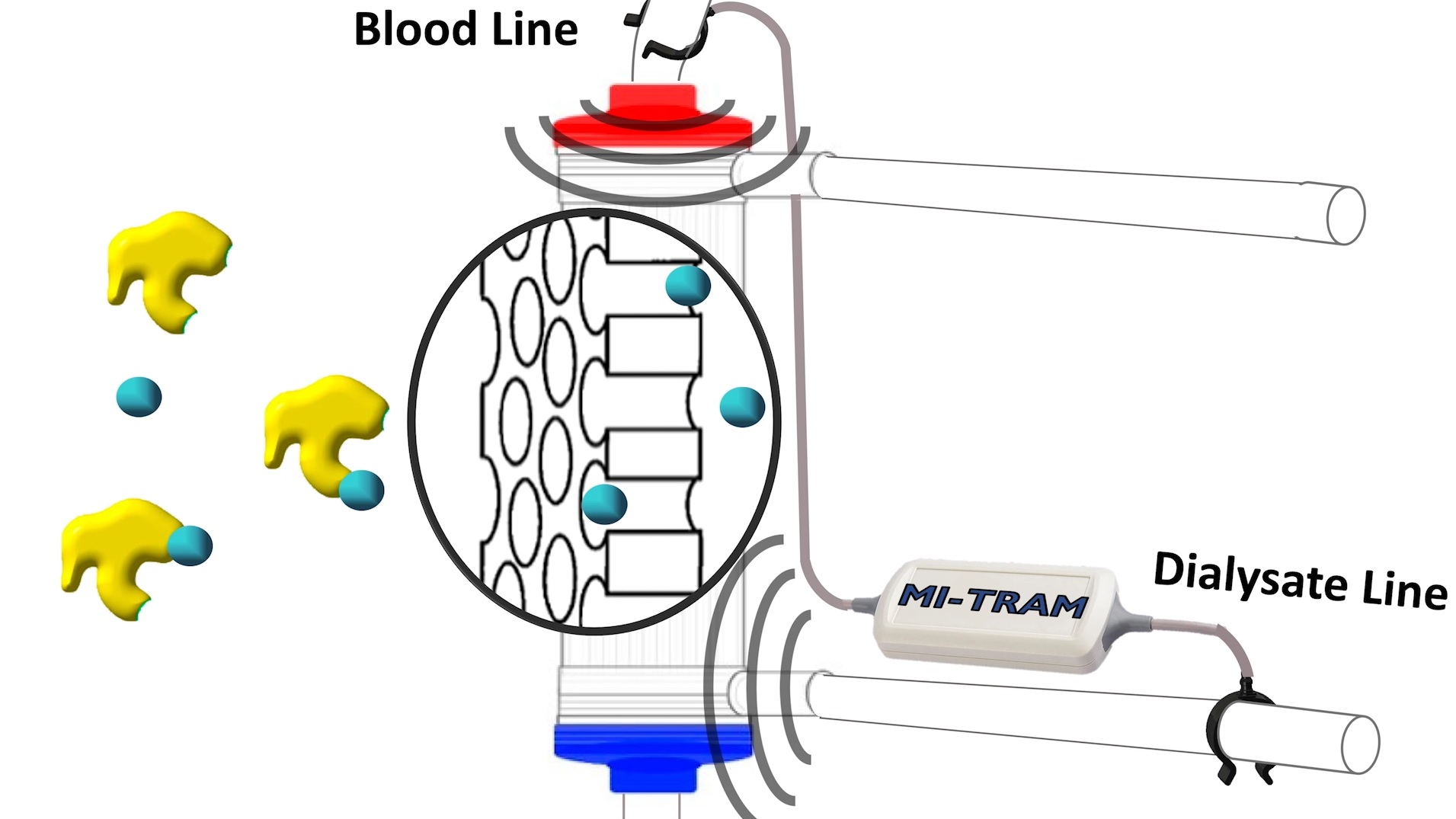 When radio waves are injected by "MI-TRAM" through the plastic tubing of the dialyzer, the PBUTs are easier disconnected from the blood proteins and so can be discharged via the dialysis filter.
When radio waves are injected by "MI-TRAM" through the plastic tubing of the dialyzer, the PBUTs are easier disconnected from the blood proteins and so can be discharged via the dialysis filter.
Wieringa proposed to miniaturize the whole setup into a fingertip-sized chip at imec, and a small smart module called "MI-TRAM" was born, which is currently under development in cooperation with the University Medical Centre of Utrecht (UMC Utrecht). It is envisioned to be compatible with any hemodialysis machine. The device will be clipped onto the tubing of the dialyzer, and its radio waves will not affect other medical devices.
In addition to this, the chip also supports the collection of data, such as body temperature, heart rate, blood flow, etc., and it can wirelessly connect to an external device. If it can be implanted in the body, the patient's condition can be monitored remotely and the patients do not have to go to the hospital for the regular check.
Wieringa and his consortium colleagues are currently working on the prototype in collaboration with UMC Utrecht.
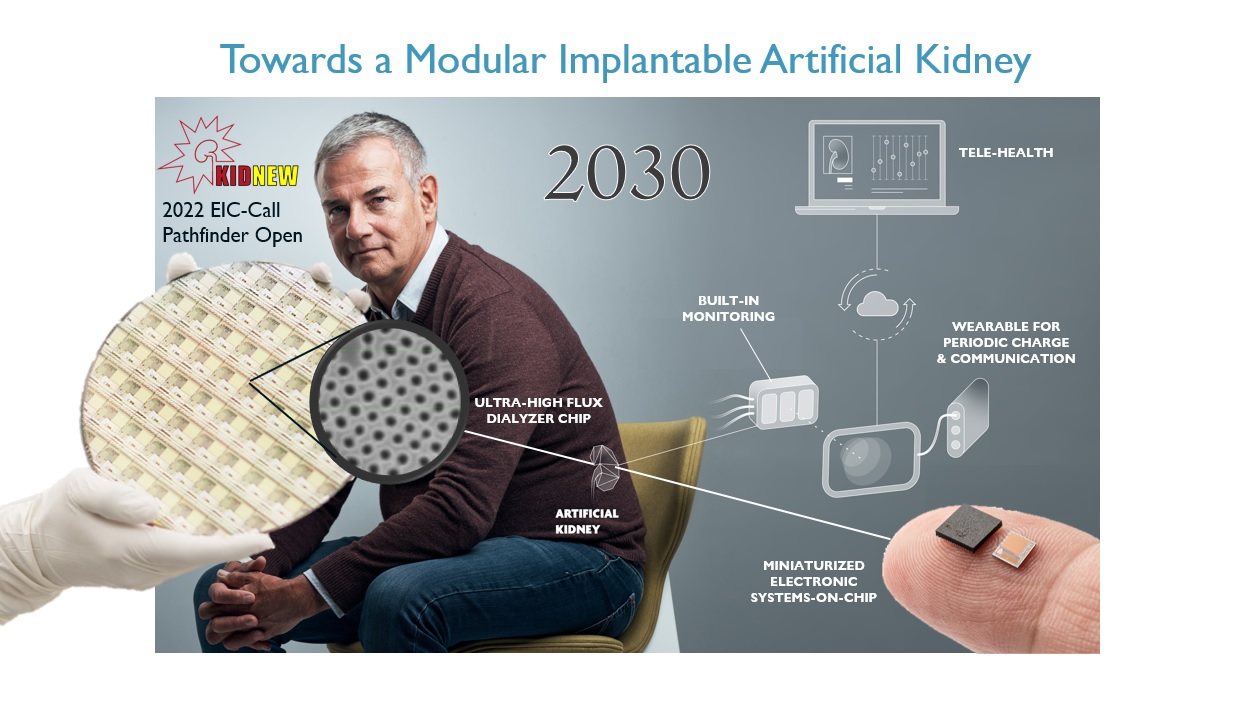 Silicon chip MEMS-technology (Micro Electro Mechanical Systems: a complex electronic component that integrates microscopic machines, sensors, electronic circuits, etc. on a single substrate) can help to create strongly miniaturized dialysis filters (Left inset) while various smart functions can be incorporated into small electronic chip of "MI-TRAM The goal is to make implantable artificial kidney by 2030.
Silicon chip MEMS-technology (Micro Electro Mechanical Systems: a complex electronic component that integrates microscopic machines, sensors, electronic circuits, etc. on a single substrate) can help to create strongly miniaturized dialysis filters (Left inset) while various smart functions can be incorporated into small electronic chip of "MI-TRAM The goal is to make implantable artificial kidney by 2030.
The realization of portable or implantable kidneys will not only dramatically improve the QOL of current dialysis patients, but will also save people around the world, who now have no access to the treatment.
"This technology has the potential to improve and save many lives, especially in third-world countries with poor infrastructure."
Artificial kidney technology will also have significant additional social and economic impacts. If the mechanism of our kidneys, which are "super water purifiers," can be artificially reproduced, this technology can also be applied to efficiently purify seawater into fresh water.
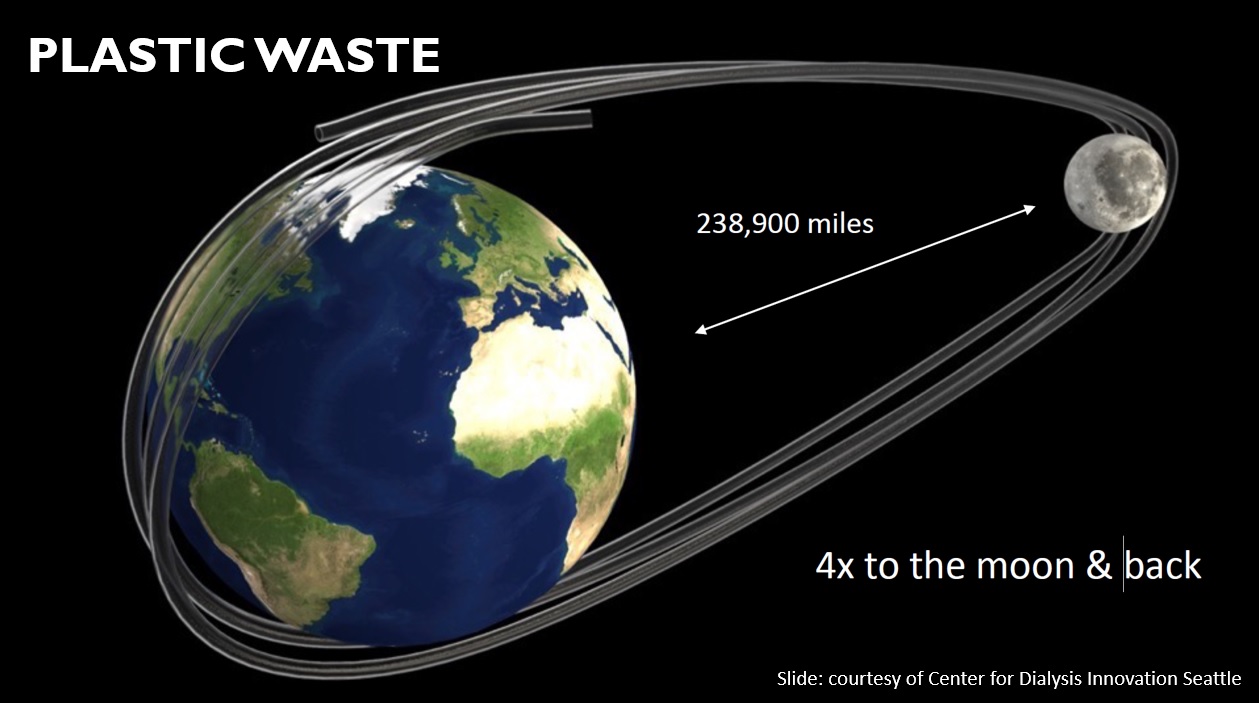 The yearly plastic tube production for dialysis is as long as four round trips between the Earth and the Moon!
The yearly plastic tube production for dialysis is as long as four round trips between the Earth and the Moon!
Furthermore, implantable artificial kidneys drastically will reduce the huge amount of water and plastic needed for dialysis. Currently, the amount of water used for hemodialysis per 12 patient clinic per year is about the same as filling one Olympic pool. And the length of disposable plastic tube produced in one year for dialysis is about 3 million kilometers, which is as long as four round trips between the earth and the moon. By eliminating such disposables, the burden on the environment will be reduced.
"So not only kidney patients but the whole world can profit from such innovations."
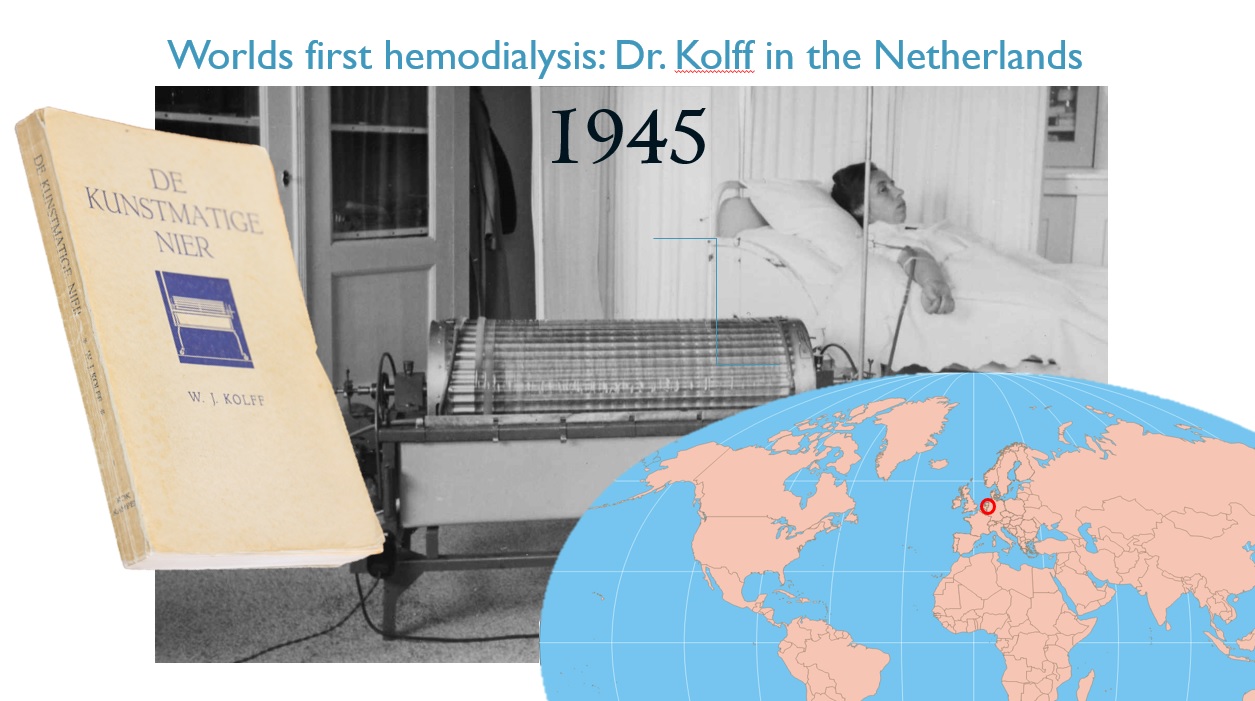 The world’s first hemodialysis took place in a small town in the Netherlands.
The world’s first hemodialysis took place in a small town in the Netherlands.
The current form of hemodialysis actually started in the Netherlands, where Wieringa lives. During the second world war, doctor Willem Kolff developed a dialysis machine in a small town called Kampen, using cellophane sausage skin, a T-ford water pump, a sewing machine engine, etc.
In 1943, when a young woman was brought to him and fell into coma due to kidney failure, he used his dialysis machine to purify her blood and demonstrated its effectiveness, and in 1945, he successfully saved the life of a patient with acute renal failure. After the war, Dr. Kolff went to the United States to continue his research on artificial kidneys, establishing the basis for dialysis treatment.
After President Nixon in 1972 decided that the US government covers the cost of dialysis, this treatment has become widespread. Interestingly, 90% of patients at that time were doing dialysis at home.
But unfortunately, developing truly portable, wearable or even implantable dialysis machine did not attract commercial interest in the industry and investment for such improvements practically stopped. Nowadays only a small fraction does home dialysis and the treatment has changed little since 1970s. The reason is that in-centre dialysis is much more profitable from the provider’s perspective.
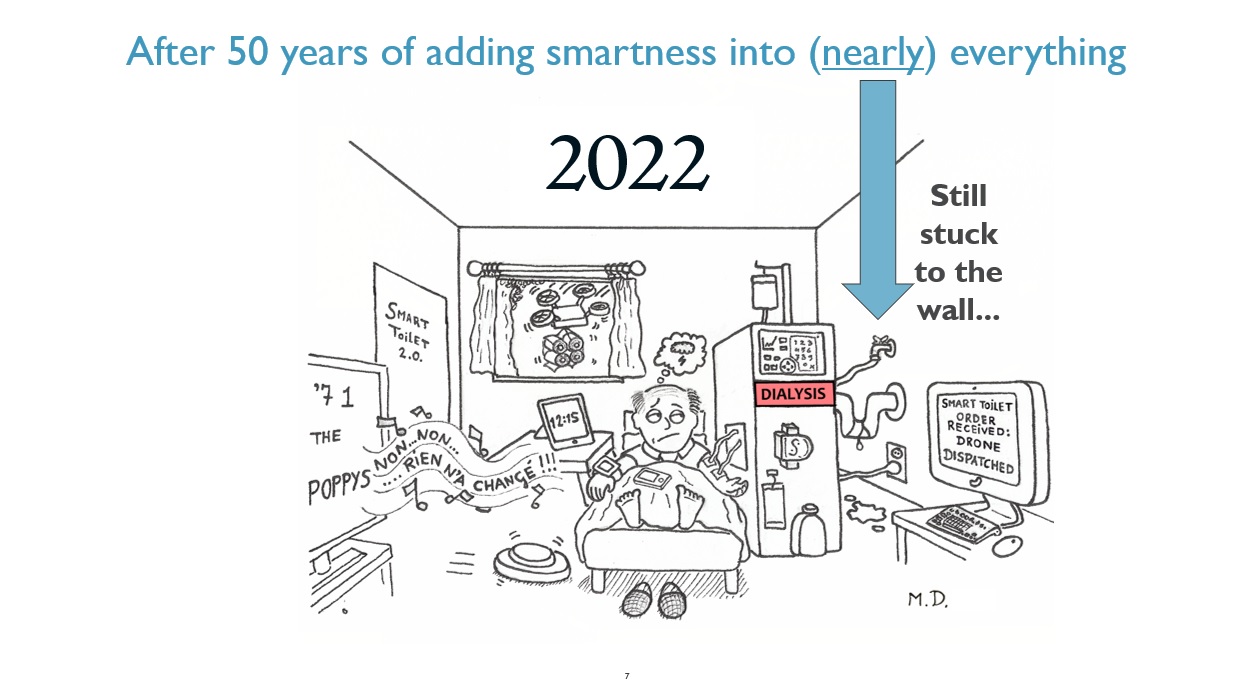 Fifty years after hemodialysis became widespread, dialysis patients are still forced to live inconveniently, despite all the progress of other technologies around them.
Fifty years after hemodialysis became widespread, dialysis patients are still forced to live inconveniently, despite all the progress of other technologies around them.
"If it created the same interest as the ‘next-generation PlayStation’, then portable and wearable dialysis machines would have already be commercially available", Wieringa said.
The recent Covid pandemic – for which dialysis patients are a high-risk group – exposed a strong point of home dialysis: At home, patients could far better isolate themselves and reduce the risk than those that had to travel to dialysis centres. Combining this with the unprecedented technological potential for miniaturization, it seems that the time is right to change course.
 The European Parliament takes kidney health very serious and on June 15th 2022 discussed the urgent need for innovation with the European Kidney Health Alliance (EKHA) where Dr. Wieringa (the 2nd person from the right) spoke.
The European Parliament takes kidney health very serious and on June 15th 2022 discussed the urgent need for innovation with the European Kidney Health Alliance (EKHA) where Dr. Wieringa (the 2nd person from the right) spoke.
Wieringa argues that patients, doctors, nurses, policy makers, investors, entrepreneurs, engineers and many other stakeholders have to work together. The investment required to realize the implantable artificial kidney is estimated between 500 million and 2 billion euros (about 70 to 280 billion yen). That sounds astronomically, but in fact this is an amount equivalent to build a 50 to 200 km length of highway in many countries.
“If funds are efficiently raised and excellent research groups from all over the world indeed unite their efforts, the artificial implantable kidney can be realized by 2030. It may sound like the ‘Kennedy statement’ regarding the moon mission, and it can also become just as true, provided we get the green light.”
Experts who want to collaborate with Dr. Wieringa's project, companies wanting to invest in the potential of innovation, people who want to explore collaboration in other industries, etc… any cooperation is possible. First of all, please contact them below.
Contact for the project of Dr. Wieringa:

Organizations connected by the Decade of the KidneyTM, a global initiative launched by the American Association of Kidney Patients (AAKP). All actively work on breakthrough Research and Development, supported by informed policy makers facilitating funding.
Abbreviations: EKHA: European Kidney Health Alliance; KHI: Kidney Health Initiative; MEP: Member of European Parliament; EKPF: European Kidney Patient Federation; AAKP: American Association of Kidney Patients, EDTNA/ERCA: European Dialysis and Transplant Nurses Association – European Renal Care Association; NIH: National Institute of Health; HHS: Human Health Service; CMS: Centers for Medicare and Medicaid Services; FDA: Food and Drug Administration; ISN: International Society of Nephrology; ERA: European Renal Association; ASN: American Society of Nephrology, HDU: Home Dialyzors United; ESAO: European Society of Artificial Organs; IFAO: International Federation of Artificial Organs; ASAIO: American Society for Artificial Internal Organs; APSAO: Asian Pacific Society of Artificial Organs.